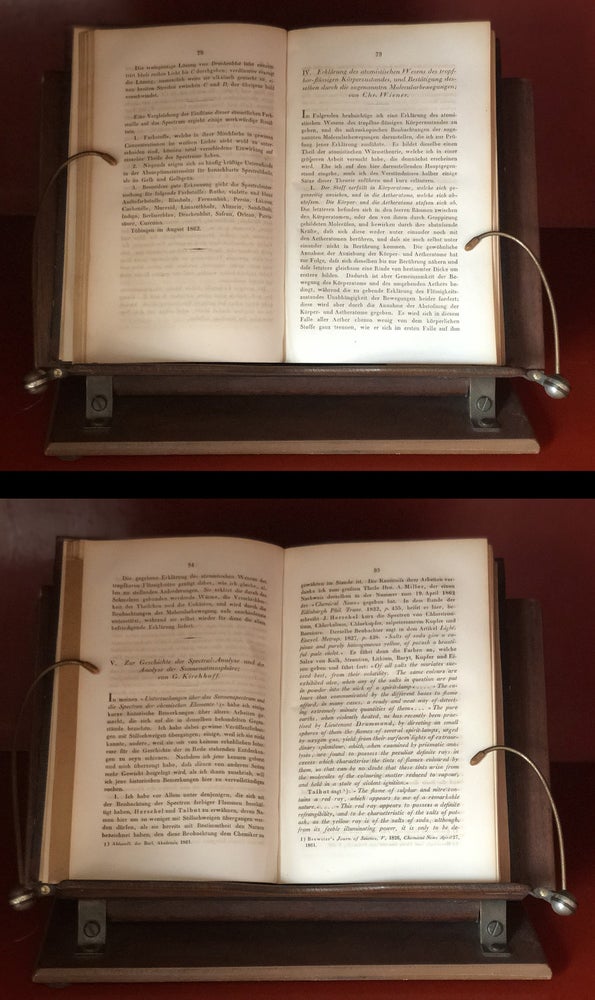Erklarung des atomistischen Wesens des tropfbar-flussigen Korperzustandes, und Bestatigung desselben durch die sogenannten Molecularbewegungen (Wiener, pp. 79-94) WITH Zur Geschichte der Spectral-Analyse und der Analyse der Sonnenatmosphäre, (Kirchhoff, pp. 94-111) in Annalen der Physik und Chemie 118, 1863
Leipzig: Johann Ambrosius Barth, 1863. 1st Edition. FIRST EDITION, full bound volume, OF WIENER’S 1863 PAPER PROVIDING THE FIRST SCIENTIFIC ANALYSIS OF THE CAUSE OF BROWNIAN MOTION – THE FIRST QUALITATIVE IDENTIFICATION OF THE INTERNAL MOLECULAR CAUSE OF BROWNIAN MOTION. Information on Kirchhoff’s solar spectral analysis paper – the last of three important ones -- appears further down.
WIENER: While Brown suspected that the motion has biological causes, Wiener “relates Brownian motion to inherent fluctuations of the suspending fluid” and was the first to prove that Brownian motion is a consequence of the molecular movements of the liquid in question (Philipse, Brownian Motion, 12).
Brownian motion is the random movement of particles suspended in a fluid (a liquid or a gas) caused by collisions with molecules of the fluid. It was one of the first indications of the existence of atoms and molecules. In 1863, about 36 years after Robert Brown first wrote about Brownian motion, the German mathematician Ludwig Christian Wiener (1826–1896) “studied Brownian motion by optical microscopy on what we now call colloidal silica sol, which he prepared by precipitation of an aqueous silicic acid solution. Wiener noted that the motion of the silica particles was too erratic to be caused by liquid convection or mechanical undulations” (ibid). Through this work, he was able to rule out external influences such as temperature differences or evaporation as causes for Brownian motion, and in doing so determined that Brownian motion must result from some force within the fluid.
Wiener’s work is close to the modern theory of Brownian motion was Wiener in 1863 and the mathematical model he built, commonly used in a range of applications, is still known as the “Wiener Process” (Nelson, Dynamical Theories of Brownian Motion).
KIRCHHOFF: Kirchhoff’s 1863 paper on the history of spectral analysis and analysis of the sun's atmosphere "Zur Geschichte der Spectral-Analyse und der Analyse der Sonnenatmosphäre,” pp. 94-111. Published between 1861 and 1863, this is the last of Kirchhoff’s three “great papers” on the subject. Working with Fraunhofer, he had cataloged and measured thousands of spectral lines, including many new elements such as rubidium and cesium. By further experimenting with sunlight, the spectra of different elements, and Fraunhofer's spectrum drawings, Kirchhoff was able to decode the sun's spectrum. The dark lines and their position indicated that the sun contained such familiar elements as sodium, magnesium, iron, calcium, copper, and zinc” (NASA, Technology Through Time #39: Solar Spectroscopy). Item #1451
CONDITION & DETAILS: 8vo. Solidly bound in maroon publisher’s boards; minor rubbing at the edge tips; gilt-lettered at the spine. Small hand-lettered paper library sticker on spine. Bright and clean throughout. Very good condition.
TITLES: “Erklärung des atomistischen Wesens des tropfbar-flüssigen Körperzustandes, und Bestätigung desselben durch die sogenannten Molecularbewegungen” (Wiener) WITH “Zur Geschichte der Spectral-Analyse und der Analyse der Sonnenatmosphäre,” (Kirchhoff).
Price: $375.00

